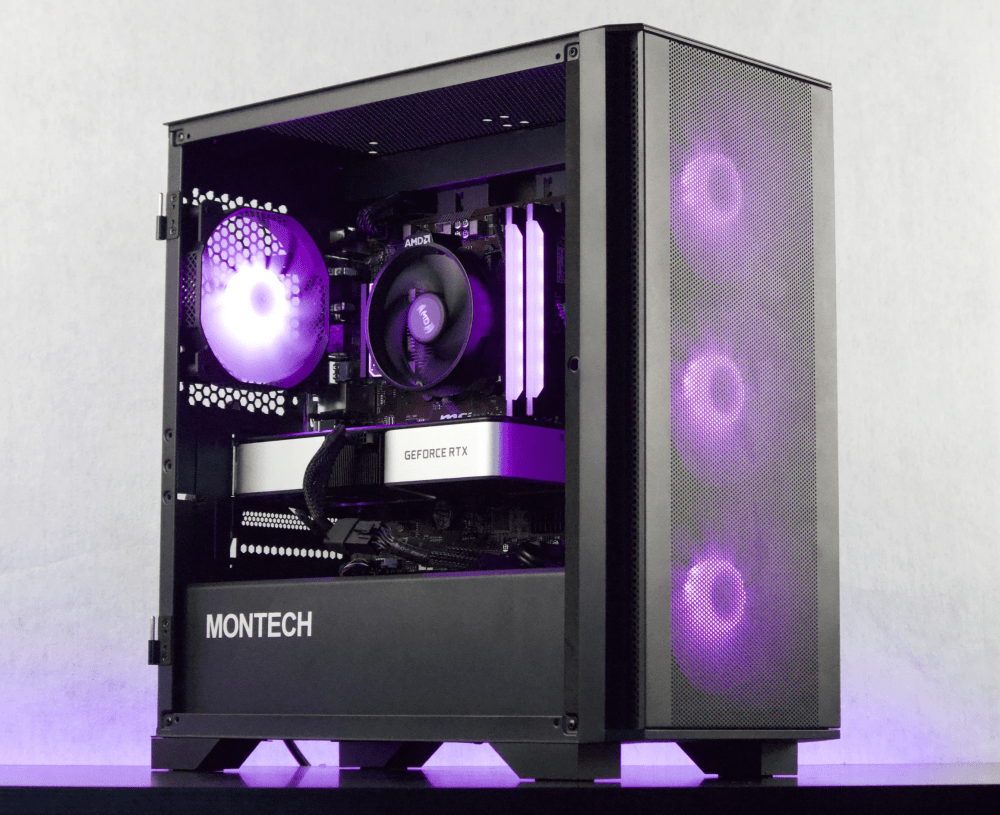Welcome to our latest blog post on determining the age of a GPU! If you're a gamer or a computer enthusiast, you know that a graphics processing unit (GPU) is an essential component for delivering stunning visuals and smooth gameplay. But have you ever wondered how long your GPU has been used? Determining the age of a GPU can be useful for various reasons, such as assessing its performance capabilities, evaluating its lifespan, or even making an informed decision about whether it's time for an upgrade. In this blog post, we will explore different methods to help you determine how long a GPU has been used, as well as provide some valuable insights on maintaining and prolonging its lifespan. So, let's dive in and uncover the secrets behind your GPU's age!
Understanding GPU Usage: Key Factors and Importance
Before delving into the specifics of determining the age of a GPU, it's crucial to have a solid understanding of GPU usage and its significance. GPU usage refers to the percentage of the GPU's processing power being utilized at any given time. It indicates how actively the GPU is being used to handle graphical tasks and calculations.
Several key factors contribute to GPU usage, including:
-
Gaming: Gamers heavily rely on GPUs to render high-resolution graphics and deliver smooth gameplay. The more graphically demanding a game is, the higher the GPU usage will be.
-
Graphics-intensive applications: GPU usage also increases when running applications that require substantial graphical processing power, such as video editing software, 3D modeling applications, or scientific simulations.
-
Multi-monitor setups: If you have multiple monitors connected to your GPU, it will require additional processing power to extend the desktop across these displays, resulting in higher GPU usage.
-
GPU-accelerated tasks: Certain tasks can leverage the GPU's parallel processing capabilities to accelerate performance, such as video encoding, rendering, and machine learning algorithms.
Understanding GPU usage is crucial because it helps monitor the workload on your GPU, allowing you to assess its performance capabilities and potential limitations. By keeping an eye on GPU usage, you can identify any bottlenecks, ensure optimal performance, and prevent overheating or performance degradation issues. Additionally, monitoring GPU usage can help you determine if your GPU is being overused, which may impact its lifespan.
In the next sections, we will explore various methods to determine the age of your GPU, providing you with valuable insights into its usage history and overall health.
How to Check the Age of Your GPU
Now that we understand the importance of determining the age of a GPU, let's explore some methods to help you uncover this information. By knowing the age of your GPU, you can gain valuable insights into its usage history and make informed decisions about its performance capabilities and potential lifespan. In this section, we will discuss three primary methods for checking the age of your GPU: locating the manufacturing date, interpreting serial numbers, and checking purchase records. Let's dive in!
Locating the Manufacturing Date
One of the most straightforward ways to determine the age of your GPU is to locate the manufacturing date. GPU manufacturers often incorporate the manufacturing date into the product's serial number or other identifying codes. By decoding this information, you can estimate when the GPU was produced.
To find the manufacturing date, start by identifying the serial number or product code on your GPU. This information can typically be found on a sticker or printed directly on the GPU. Once you have the serial number, visit the manufacturer's website or contact their customer support to inquire about how to interpret the serial number to determine the manufacturing date. Manufacturers often have specific formats or guidelines for decoding the serial numbers, so it's important to follow their instructions accurately.
Interpreting Serial Numbers
Serial numbers can provide valuable information about the age of your GPU. GPU manufacturers often include specific codes or patterns within the serial numbers that indicate the manufacturing date. These codes may vary between manufacturers, so it's essential to consult the manufacturer's documentation or reach out to their customer support for guidance on interpreting the serial number.
While the specific format and codes used in serial numbers can differ, some common elements may provide insights into the manufacturing date. These can include digits representing the year, month, or week of production. By decoding these elements, you can estimate the age of your GPU.
Checking Purchase Records
If you have access to your purchase records, checking them can be another effective method to determine the age of your GPU. Look for the date of purchase on your receipt or invoice. This will give you a rough estimate of how long you have been using the GPU. However, it's important to note that the purchase date might not necessarily align with the manufacturing date, especially if you bought the GPU from a retailer who had it in stock for an extended period.
In the next section, we will explore how to check the usage of your GPU, which can provide additional insights into its history and lifespan.
How to Check the Usage of Your GPU
Determining the age of a GPU is essential, but it's equally important to understand how to check its usage. Monitoring the usage of your GPU can provide valuable insights into its workload, performance, and potential wear and tear. In this section, we will explore three methods for checking the usage of your GPU: using Task Manager, software tools to track GPU usage, and understanding GPU usage metrics. Let's get started!
Using Task Manager to Determine Usage
One of the easiest ways to check the usage of your GPU is by using the built-in Task Manager on your Windows operating system. The Task Manager provides real-time information about the processes and applications running on your system, including GPU usage.
To access the Task Manager, right-click on the taskbar and select "Task Manager" from the menu. In the Task Manager window, navigate to the "Performance" tab. Here, you will find various performance metrics, including CPU, memory, and GPU usage. Click on the "GPU" option to expand the details and view the GPU usage percentage.
Keep in mind that the Task Manager provides a basic overview of GPU usage and may not provide in-depth metrics or historical data. For more comprehensive monitoring, consider using specialized software tools.
Software Tools to Track GPU Usage
Several software tools are available that provide more detailed information and tracking capabilities for GPU usage. These tools offer features such as real-time monitoring, historical data, and customizable alerts. Some popular software tools for tracking GPU usage include:
-
MSI Afterburner: A widely used utility that allows you to monitor GPU usage, temperature, clock speeds, and more. It also offers advanced features like custom fan profiles and overclocking.
-
GPU-Z: A lightweight tool that provides detailed information about your GPU, including usage, clock speeds, memory usage, and more. It offers a simple and intuitive interface.
-
HWiNFO: A comprehensive hardware monitoring tool that provides detailed information on various components of your system, including GPU usage, temperatures, voltages, and more.
These software tools can help you track usage over time, identify any abnormal behavior, and provide insights into the workload your GPU is handling.
Understanding GPU Usage Metrics
When checking the usage of your GPU, it's essential to understand the different metrics associated with GPU usage. The most common metric is GPU usage percentage, which indicates the proportion of the GPU's processing power being utilized. A higher percentage indicates more intense workload and usage.
Additionally, some software tools may provide metrics such as memory usage, GPU temperature, clock speeds, and fan speeds. Monitoring these metrics can help you assess the overall health and performance of your GPU.
In the next section, we will explore signs of a worn-out or overused GPU, which will further assist you in evaluating the condition of your graphics card.
Signs of Worn Out or Overused GPU
As GPUs age and are subjected to heavy usage, they may start exhibiting signs of wear and tear. It's important to be aware of these signs as they can indicate that your GPU is reaching its limits or may need attention. In this section, we will discuss three common signs of a worn-out or overused GPU: performance degradation, visual artifacts and glitches, and overheating and noise issues. Let's explore each of these signs in detail.
Performance Degradation
One of the most noticeable signs of a worn-out or overused GPU is a decline in performance. You may experience lower frame rates, stuttering, or lag in games and applications that used to run smoothly. Tasks that previously required minimal GPU usage may start to strain the graphics card. This performance degradation can be attributed to various factors, such as aging components, increased demand from newer software, or inadequate cooling.
If you notice a significant decrease in performance, it may be time to assess the condition of your GPU and consider potential upgrades or maintenance.
Visual Artifacts and Glitches
Another indication of an aging GPU is the appearance of visual artifacts and glitches on your screen. These can manifest as flickering or distorted images, random pixels or lines appearing on the screen, or color abnormalities. Visual artifacts and glitches are often a result of the GPU struggling to render graphics accurately due to deteriorating hardware or insufficient cooling.
If you consistently encounter visual abnormalities while using your GPU, it's a clear sign that your GPU may be reaching the end of its lifespan.
Overheating and Noise Issues
Overheating and excessive noise are common problems associated with GPUs that have been used extensively. As a GPU works harder to handle demanding tasks, it generates more heat. If the cooling system is inadequate or if dust and debris accumulate on the GPU, it can lead to overheating. This can cause the GPU to throttle its performance or even shut down to prevent damage.
Additionally, increased usage and heat can cause the fans on the GPU to spin faster, resulting in louder noise levels. If you notice your GPU running hot or your fans operating at high speeds consistently, it's a sign that your GPU may be under strain and in need of maintenance or replacement.
By being aware of these signs, you can take proactive measures to address any issues with your GPU and make informed decisions regarding repairs, upgrades, or replacements. In the next section, we will discuss effective maintenance tips to help extend the lifespan of your GPU and ensure optimal performance.
Maintaining Your GPU to Extend Its Lifespan
To ensure the longevity and optimal performance of your GPU, it's crucial to implement proper maintenance practices. Regular maintenance can help prevent issues like overheating, performance degradation, and premature failure. In this section, we will discuss several effective maintenance tips to help extend the lifespan of your GPU. Let's explore these tips in detail.
Regular Cleaning and Dusting
Dust accumulation on your GPU and its cooling components can hinder airflow and lead to overheating. Therefore, regularly cleaning and dusting your GPU is essential. Start by shutting down your computer and disconnecting the power supply. Carefully remove the GPU from its slot and use compressed air or a soft brush to remove dust from the heatsink, fans, and other components. Be gentle and avoid using excessive force that may damage delicate parts.
Proper Heat Management
Heat is a major factor that can affect the lifespan of your GPU. To manage heat effectively, ensure that your computer case has proper airflow. Positioning fans strategically to create a balanced airflow can help dissipate heat effectively. Consider installing additional case fans or upgrading to more efficient cooling solutions like aftermarket GPU coolers or liquid cooling systems.
Balancing High-Performance Use
While it's tempting to push your GPU to its limits, prolonged high-performance use can accelerate wear and tear. To balance performance and longevity, consider optimizing the settings of your games or applications. Adjusting graphical settings to a reasonable level and avoiding excessive overclocking can help reduce the strain on your GPU and extend its lifespan.
Up-to-date Drivers Installation
GPU manufacturers regularly release driver updates that optimize performance, fix bugs, and address compatibility issues. Keeping your GPU drivers up to date is crucial for maintaining optimal functionality and stability. Check your GPU manufacturer's website periodically or utilize software tools like GeForce Experience (for NVIDIA GPUs) or Radeon Software (for AMD GPUs) to ensure you have the latest drivers installed.
By implementing these maintenance practices, you can significantly extend the lifespan of your GPU and ensure it performs optimally for a longer period. However, it's essential to understand when it's time to upgrade your GPU. In the next section, we will discuss the importance of monitoring GPU usage and lifespan, as well as provide insights on when it may be necessary to consider an upgrade.
Conclusion
In this comprehensive blog post, we have explored various methods to determine how long a GPU has been used and how to check its usage. We discussed techniques such as locating the manufacturing date, interpreting serial numbers, and checking purchase records to estimate the age of your GPU. Additionally, we explored methods like using Task Manager and software tools to track GPU usage, as well as understanding GPU usage metrics.
We also discussed the signs of a worn-out or overused GPU, including performance degradation, visual artifacts and glitches, and overheating and noise issues. Being aware of these signs can help you assess the condition of your GPU and make informed decisions regarding maintenance, repairs, or upgrades.
To extend the lifespan of your GPU and ensure optimal performance, we provided valuable maintenance tips, such as regular cleaning and dusting, proper heat management, balancing high-performance use, and keeping your GPU drivers up to date.
It's important to monitor the usage and lifespan of your GPU to assess its performance capabilities and potential limitations. Understanding when it may be time to upgrade your GPU is crucial for staying up to date with the latest technologies and ensuring smooth gaming and graphical experiences.
By following the guidelines and tips outlined in this blog post, you can effectively determine the age of your GPU, monitor its usage, and take necessary measures to maintain and prolong its lifespan.
Remember, a well-maintained GPU can provide you with years of high-quality gaming and computing experiences. Stay informed, take care of your GPU, and enjoy the best performance possible!
Looking to upgrade your GPU? Check out Jawa for killer deals on new and used graphics cards.





